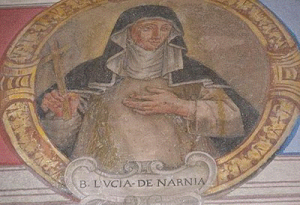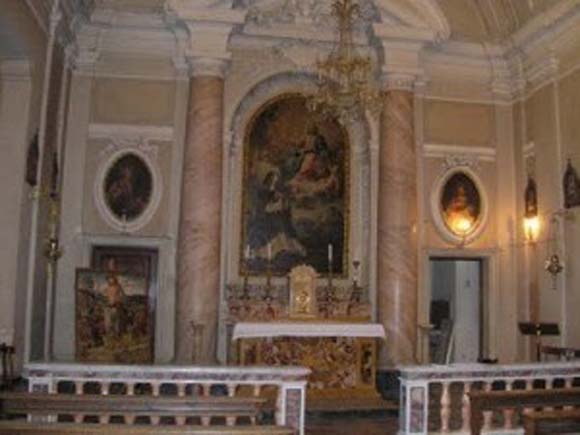
Saints This Month – 16 November: St Lucia Brocadelli of Narni
 For Lucia had many visions and they began at an early age. When she was only five years old, she had a vision of the Virgin Mary. Two years later, she had another vision, this time of the Virgin Mary accompanied by Saint Dominic. Dominic is said to have given her the scapular at this time. When she was twelve years old, Lucy made a private vow of chastity, and determined to become a Dominican nun but her path to the cloister was certainly not easy.
For Lucia had many visions and they began at an early age. When she was only five years old, she had a vision of the Virgin Mary. Two years later, she had another vision, this time of the Virgin Mary accompanied by Saint Dominic. Dominic is said to have given her the scapular at this time. When she was twelve years old, Lucy made a private vow of chastity, and determined to become a Dominican nun but her path to the cloister was certainly not easy.
Her father died when she was thirteen and she was entrusted to the care of an uncle. This uncle determined that the best course of action would be to get Lucia married as quickly as possible.He made several attempts to do so. One of these included holding a large family party. He had invited to the party the man he had chosen as Lucia’s husband, with the intention of having the couple publicly betrothed. However he had not informed Lucia of his intentions. The suitor made an attempt to put a ring on her finger, only to be slapped repeatedly for his efforts by Lucia.
Later, Count Pietro de Alessio of Milan began to seek the hand of Lucia. She was rather taken by him but felt her earlier vow to become a nun did not allow her to enter into a marriage. She then had a vision of the Virgin, St Dominic and St Catherine in which they advised Lucia to contract a legal marriage to Pietro, but to explain that her vow of virginity would have to be respected and not violated. Pietro agreed to the terms, and the marriage was formalized.
As the new mistress of the Count’s household Lucia had to manage many servants and a busy social calendar. She however made a great effort to instruct the servants in the faith and carry out acts of charity for the poor. The servants claimed that SS Catherine, Agnes, and Agnes of Montepulciano helped her make the bread she gave to the hungry. Her quirks became too much for her husband and he had her locked away for the bulk of one Lenten season. She was only visited by servants who brought her food. When Easter arrived, however, she managed to escape from Pietro back to her mother’s house and on May 8 1494 she became a Dominican tertiary. Pietro expressed his disapproval of this in a rather dramatic form, by burning down the monastery of the Prior who had given her the habit!
When Duke Ercole died on January 24 1505, the new prioress quickly found Lucia to be guilty of some unrecorded transgression, most probably of support for Savonarola’s Church reform, and placed her on a strict penance. Lucia was not allowed to speak to any person but her confessor, who was chosen by the prioress. The local provincial of the Dominican order would also not permit any member of the order to see Lucia. There are records that at least one Dominican, Catherine of Racconigi, did visit her, evidently by bilocation, and that Lucia’s earlier visits from departed saints  continued. In response to Lucia’s insistent prayer, her stigmata eventually disappeared, which caused some of the other nuns to question whether they had ever been there at all. When Lucia finally died in 1544, many people were surprised to realise that she had not died years earlier.
continued. In response to Lucia’s insistent prayer, her stigmata eventually disappeared, which caused some of the other nuns to question whether they had ever been there at all. When Lucia finally died in 1544, many people were surprised to realise that she had not died years earlier.


